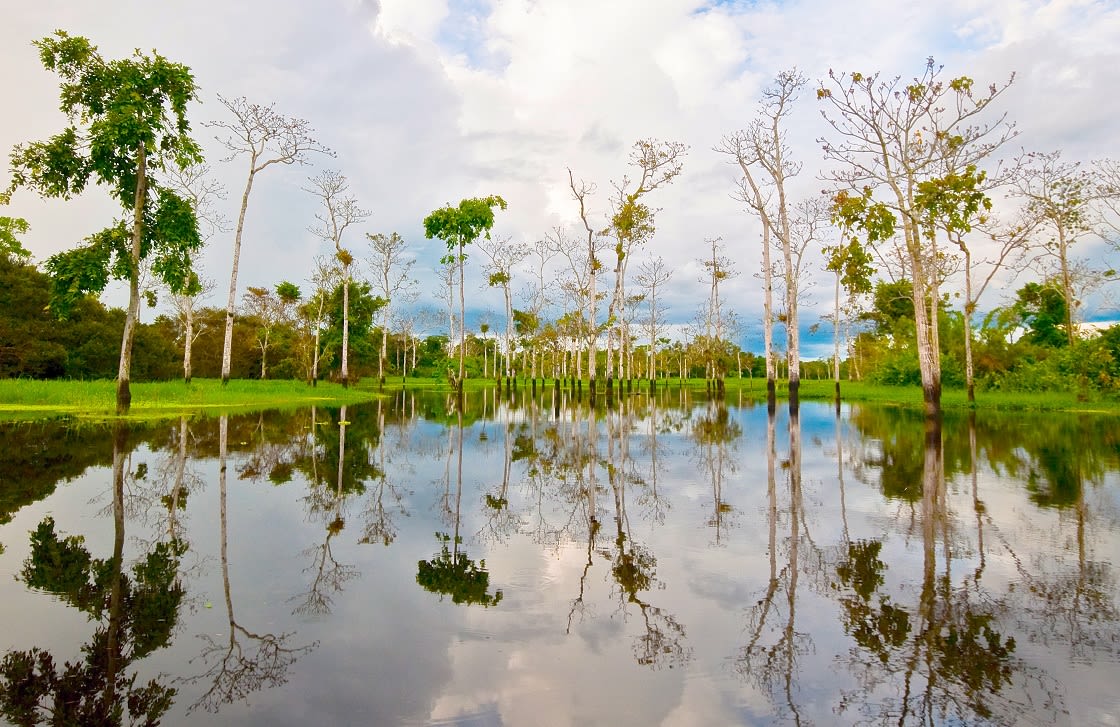
The enormous Amazon basin is made up of a web of ecosystems and unique landscapes. This region produces about 20% of the Earth’s oxygen and is vital to our survival. Due to its diverse landscape, a stable climate, and proximity to the equator, the Amazon Rainforest is known as an ecoregion, which has been defined by the WWF as a “large unit of land or water containing a geographically distinct assemblage of species, natural communities, and environmental conditions.”
The ecoregion of the Amazon is made up of a number sub-ecoregions. These can be categorized under two umbrella definitions, aquatic ecosystems (water-based systems) and terrestrial ecosystems (land-based systems). Both of these ecoregions exist within the Amazon Rainforest, and within these sections, they become even more complex, unique, and fascinating.
The Amazon Rainforest is thought to contain half of the world’s species in its canopy alone and has the highest level of biodiversity in the world. This is because its complex ecosystems contain a number of layers and different communities that have their own unique wildlife and plant life.

Blue-and-yellow Macaw sitting in a palm tree stump
An ecosystem is an entirely unique environment, and within this specific environment, every living thing is interdependent. One of the best examples and most complex examples of an ecosystem can be found in the Amazon Rainforest. The plants and animals living in an ecosystem are associated with specific climatic conditions and non-living conditions, these conditions characterize the actions that take place between the soil, plants, animals, and other living organisms. If one species were to die, it would have a wider impact on all of the other organisms in the environment.
As the largest continuous rainforest ecosystem in the world, the Amazon Rainforest is defined by the enormous Amazon River, the second largest river in the world, and the most voluminous river on Earth. The 4,000-mile-long river is at the heart of the ecosystem of the Amazon. Covering two-thirds of South America and sitting 10 degrees to the north and to the south of the equator the environments within the region vary massively. The result is a mosaic of different ecosystems that interact and rely upon each other, and on which humans also rely. Of all of the ecosystems in the world, the Amazon’s ecosystems have the most species per area and the greatest biodiversity of organisms. This means it is both important to us and to the world’s wildlife.

Igapo: The area is essentially made up of freshwater swamp forests
Known as the “lungs of our planet,” the ecosystem of the Amazon Rainforest is one of the greatest natural resources we have. Its vegetation turns carbon dioxide into oxygen and is one of the most treasured oxygen sources.
Each of the following sub-ecoregions contribute to the larger ecoregion of the Amazon Rainforest, if one of these were to disappear it would have a devastating effect on the remaining environments and the ecoregion as a whole:
The areas close to riversides are flooded during the rainy season. These areas are constantly being remodeled by the Amazon River, but are very resilient and strong.
Terra firma literally means firm earth and is essentially a forest area that is not on a floodplain. This ecosystem usually lies away from rivers.
This type of ecosystem typically exists around freshwater lakes and lower reaches of rivers. Primarily, the region receives at least six months of rainfall annually, when its trees are submerged underwater. The area is essentially made up of freshwater swamp forests.

A freshwater beach along the Tapajos river, located in Santarem
The wildlife and plant life in the Amazon have evolved over thousands of years and in such a way that every living creature relies on another to survive. This means the ecosystems of the Amazon Rainforest are extremely fragile.
Today more than 20% of the Amazon Rainforest has been destroyed. In fact, the California Institute of Technology has reported that a football-sized area of rainforest is being destroyed every second. Conservationists can’t keep up with the 2,000 trees that are cut down a day. This destruction will not only affect the species that only exist in the Amazon, but also humans. Not only are we destroying our lungs and supply of oxygen, but also our supply of natural resources, such as medicines, we source 25% of medicinal ingredients from rainforest plants.
Development projects that have taken place over the years have removed the precious Amazon forest that we rely on. These projects have included building dams, roads, and oil, and gas pipelines in the region. Climate change throughout the world has also had a negative impact on the Amazon Rainforest, making the region vulnerable to forest fires.
A number of conservation projects exist focusing on preserving and protecting the current ecosystems, such as the WWF Varzea Project that focused on Santarém and Lower Amazon Para State region in Brazil. The project helped both the residents of the region with sustainability as well as working to protect parts of the rainforest that are in danger.
Positive changes have been and are being made to ensure the important ecosystems of the Amazon Rainforest will continue to exist. A large network of protected areas is now in place, a reduction in deforestation has been reported, and monitoring and enforcement of laws in the region have improved. One way to sustain and support these protected is by visiting them and paying their entrance fees. You can visit the incredibly diverse and impressive Amazon ecosystems responsibly by taking one of our eco-friendly Amazon riverboat cruises.
While Rainforest Cruises aim to provide accurate and up-to-date information, we make no representations as to the accuracy or completeness of any information herein or found by following any link on this site. Rainforest Cruises cannot and will not accept responsibility for any omissions or inaccuracies, or for any consequences arising therefrom, including any losses, injuries, or damages resulting from the display or use of this information.




